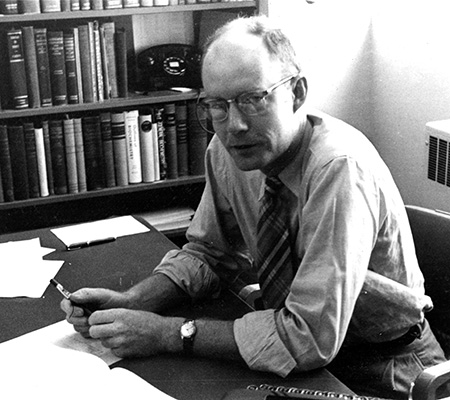In memoriam: Daniel Atkinson
Daniel Edward Atkinson, an emeritus professor of chemistry and biochemistry at UCLA and a member of the American Society of Biochemistry and Molecular Biology since 1957, died Feb. 2. He was 102.

Atkinson was born April 8, 1921 in Pawnee City, Nebraska, the eldest of four children of Max, a farmer and welder, and Amy Neiswanger Atkinson. He earned a B.Sc. at the University of Nebraska at Lincoln in 1942 and went immediately into the Navy as an officer, serving on ships from 1943 to 1946. He then enrolled in Ph.D. studies at Iowa State University with Sidney Fox and earned his doctorate in 1949.
After short stints at the California Institute of Technology and the Argonne National Laboratory, Atkinson joined the chemistry department at UCLA as an assistant professor. He was promoted to associate professor in 1956 and full professor in 1962. His laboratory was active until he retired in 1992, training more than 30 Ph.D. students and more than 20 postdoctoral fellows and visiting faculty.
Atkinson's research pioneered the field of metabolic regulation, allowing for development of the concept of "energy charge," now a main topic of biochemistry textbooks. He was also responsible for the present understanding of the biological role of the urea cycle in pH regulation. His 1977 monograph "Cellular Energy Metabolism and its Regulation" presented a global view of the logic of metabolism; it is still widely read.
Atkinson discovered that key regulatory enzymes possessed allosteric binding sites for the energy carrriers adenosine mono-, di- and triphosphate that enabled them to respond appropriately to cellular energy charge. He and his student James Hathaway introduced this concept in a classic 1963 paper in the Journal of Biological Chemistry, “The Effect of Adenylic Acid on Yeast Nicotinamide Adenine Dinucleotide Isocitrate Dehydrogenase, A Possible Metabolic Control Mechanism.”
By 1982, Atkinson had embarked on the study of urea biosynthesis from the standpoint of balance reactions. He determined that urea production derives from using exactly equal amounts of ammonium ion and bicarbonate, producing a molecule that is readily excreted in the urine and that thus totally removes both of the products of protein catabolism.
In addition to his longtime membership in the society, Atkinson served as an ASBMB Council member from 1979 to 1982. He was a member of the Journal of Biological Chemistry editorial board from 1966 to 1971 and an associate editor from 1972 to 1977. He was also a member of the American Chemical Society, the American Society of Microbiology and the American Physiological Society. In 1975, the University of Nebraska awarded him an honorary D.Sc. degree. In 2016, the UCLA Department of Chemistry and Biochemistry established prizes in metabolic chemistry named for Atkinson and his colleague Charles A. West to provide summer research fellowships for undergraduates and graduate students.
Atkinson was married for 70 years to Elsie Ann Hemmingson, who died in 2018. They had five children: Kristine Ruth, Owen Rolf, Joyce Elain, Ellen Lee and David Eric. He is survived by 14 grandchildren and 8 great-grandchildren.
(This obituary was adapted from a remembrance by Steven and Catherine Clarke published on the UCLA website.)
Enjoy reading ASBMB Today?
Become a member to receive the print edition four times a year and the digital edition monthly.
Learn moreGet the latest from ASBMB Today
Enter your email address, and we’ll send you a weekly email with recent articles, interviews and more.
Latest in People
People highlights or most popular articles

Embrace your neurodivergence and flourish in college
This guide offers practical advice on setting yourself up for success — learn how to leverage campus resources, work with professors and embrace your strengths.

Survival tools for a neurodivergent brain in academia
Working in academia is hard, and being neurodivergent makes it harder. Here are a few tools that may help, from a Ph.D. student with ADHD.

Quieting the static: Building inclusive STEM classrooms
Christin Monroe, an assistant professor of chemistry at Landmark College, offers practical tips to help educators make their classrooms more accessible to neurodivergent scientists.

Hidden strengths of an autistic scientist
Navigating the world of scientific research as an autistic scientist comes with unique challenges —microaggressions, communication hurdles and the constant pressure to conform to social norms, postbaccalaureate student Taylor Stolberg writes.

Richard Silverman to speak at ASBMB 2025
Richard Silverman and Melissa Moore are the featured speakers at the ASBMB annual meeting to be held April 12-15 in Chicago.

Women’s History Month: Educating and inspiring generations
Through early classroom experiences, undergraduate education and advanced research training, women leaders are shaping a more inclusive and supportive scientific community.
